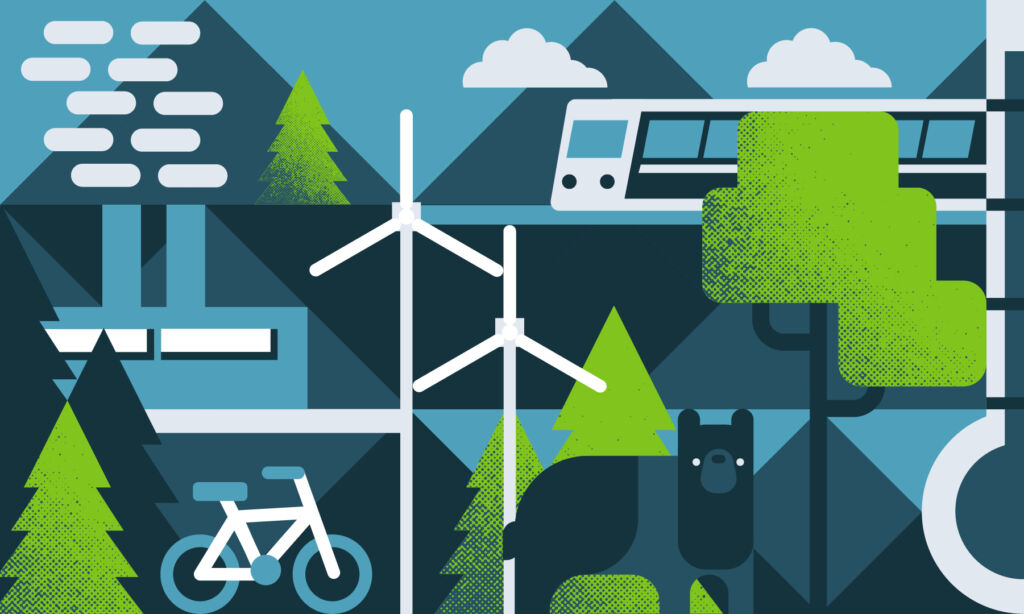For years Canada has been seeking to have it both ways, being climate leaders while supporting the growth of oil and gas production and exports. That cognitive dissonance is even more apparent after the past month in Canadian climate policy. Let’s recap:
On March 29, the federal government released its 2030 Emissions Reduction Plan (ERP) with policies intended to achieve Canada’s greenhouse gas emission reduction target of 40% below 2005 levels by 2030.
On April 4, the Intergovernmental Panel on Climate Change released its latest report on mitigation of climate change, which warned that “without immediate and deep emissions reductions across all sectors, limiting global warming to 1.5 C is beyond reach.”
On April 6, the federal government approved the Bay du Nord oil and gas project off the coast of Newfoundland.
On April 7, the federal government released its 2022 budget, which included $9.1 billion in spending on the new ERP and, more controversially, $2.6 billion for a new tax credit for carbon capture and storage.
What does this all mean for Canada’s efforts to combat the climate crisis? Here are our key takeaways on federal climate policy.
Canada’s climate plan still falls short
The government was required to produce its first Emissions Reduction Plan (ERP) under the new Canadian Net-Zero Emissions Accountability Act. However, not much has changed since the last federal climate plan, A Healthy Environment and a Healthy Economy, was released in December 2020. Indeed, in light of the growing climate emergency which featured massive wildfires and floods, and a heat dome event in B.C. that shattered the all-time Canadian temperature record, this lack of progress is disappointing. In many ways the ERP is still a plan to make a plan.
The ERP outlines steps towards the government’s 40% reduction target from 730 megatonnes (Mt) today to around 440 Mt by 2030. Emission reductions are expected to come from every part of the economy through a mix of broad-based measures like the federal carbon price as well as measures targeted to individual sectors. The plan commits $9.1 billion in new climate spending over the next seven years, all of which was delivered in the recent budget.
Key new policies in the transportation sector include sales mandates for zero-emission vehicles (ZEV) of 20% by 2026 and 60% by 2030 for light duty vehicles, and of 15% by 2030 for medium- to heavy-duty vehicles. As part of this ZEV strategy, the government is spending $1.7 billion on ZEV purchase incentives and $1.2 billion on new charging stations and other infrastructure.
On buildings, the plan expands existing programs to fund building retrofits and introduces an interesting array of new green building strategies at a total cost of just over $1 billion. Adding a low-income stream for home energy retrofits is an important step for redressing programs that have historically only benefitted high-income homeowners. More resources are required to fund retrofits in multi-unit buildings.
Canada’s electricity generation sector is already 80% non-emitting, but some provinces still depend on fossil fuels for power generation and all regions will need to meet growing demand for electricity in the coming decades. Rather than lean into proven renewable options like wind, solar and hydro power, the ERP offers small modular nuclear reactors (SMRs) and carbon capture, utilization and storage (CCUS) as options for closing the gap. On the plus side, there is a renewed focus on connecting power grids across the country, which will significantly smooth the technical hurdles of adopting some forms of renewable energy. In total, $877 million is set aside for electricity.
There are no quick fixes for the agriculture sector. Emissions are projected to stay flat through 2030 while government efforts focus on research and development. The plan dedicates $1 billion for new agricultural technologies and practices.
The ERP also tops up the Low Carbon Economy Fund with $2.2 billion in new funding. The LCEF is a general-purpose program for backing emission-reduction projects typically led by other levels of government.
Taken together, this suite of policies will put Canada on a path to cutting overall emissions in the next decade. However, the plan’s promised reductions aren’t quite what they appear. The government’s own modeling of the measures in the ERP only add up to a 36% reduction by 2030, well short of the 40% target. The ERP is still a plan to make a plan in many key areas, including on methane regulations and green buildings.
Hitting the 2030 emissions target also relies on a 30 Mt reduction from nature-based carbon offsets, which receive $780 million in new investment under the ERP. The vast majority of these promised reductions come from forests, which have been a net source of carbon dioxide in recent years. Record fires in Western Canada in particular call into question any claims that tree planting or minor changes in forest management practices can reasonably count towards our GHG reduction targets.
While Canada should conserve its remaining intact forests as much as possible, trying to claim credit in carbon terms in lieu of actual emissions reductions is not a climate strategy. If both carbon offsets and “under development” policies are excluded, Canada’s own modeling only projects a 32% reduction in emissions by 2030. That’s short of our own target and even more inadequate in the context of Canada’s fair share of global reductions of 60% below 2005 levels by 2030.
Finally, the biggest challenge for emissions mitigation policy is the industrial sector. Oil and gas production alone accounts for more than a quarter of Canada’s emissions. The federal government has previously promised a cap on oil and gas sector emissions but the details are not included in this plan. The ERP essentially hand-waves an 81 Mt drop in oil and gas sector emissions—a 42% reduction from current levels—which is particularly improbable given the government’s assumption that crude oil production will increase by 910,000 barrels per day (+22%) between now and 2030.
Canada remains stubbornly committed to producing fossil fuels
Indeed, only one week after releasing this climate plan, the federal government approved the Bay du Nord offshore oil project near Newfoundland (offshore projects require both federal and provincial sign-off). The project has an expected lifespan of 30 years and will produce upwards of 200,000 barrels of oil per day at its peak. By approving this project, the government is essentially betting on the failure of the Paris Agreement and planning for significant oil exports well past 2050.
The export piece is key. The government’s claim that Bay du Nord is a “clean oil” project relies on the fact that the fossil fuels we produce are mainly burned in other countries. In the upside-down world of national emissions accounting, Canada is not responsible for emissions from burning the oil it exports, even though it doesn’t matter to the global climate where in the world the oil is ultimately burned.
Nevertheless, how does the government expect oil production to increase by 22% by 2030—and stay high for decades—while emissions from the sector fall 42% by 2030 before ultimately reaching net-zero by 2050? The government’s answer seems to be through carbon capture utilization and storage (CCUS) technology, a controversial centrepiece of the new federal budget.
Budget 2022 bets big on new fossil fuel subsidy
The biggest new climate-related spending item in the budget is in fact a $2.6 billion CCUS investment tax credit. That initial amount is over five years, and starting in 2026/27 is expected to cost $1.5 billion annually. Some of that money will go toward direct air capture technology development, an area that has made significant gains but remains incredibly resource intensive and is unlikely to scale in the coming decades. Another portion will go to heavy industrial processes that are difficult to decarbonize but remain essential in a clean economy, such as steel and cement.
However, a significant cut of this money will go toward oil and gas producers and conventional power plants—a new subsidy for a fossil fuel sector that declared $22 billion in domestic profits last year. Already, federal rules mean oil and gas companies only pay the carbon price on a fraction of their emissions. The feds are also developing a new GHG Offset Protocol that will allow the industry to further avoid direct emissions reductions. The CCUS tax credit is yet another escape hatch for the fossil fuel industry to continue with business-as-usual based on a technology that is very expensive and does not scale to the size of the climate challenge.
On the industrial side, the budget makes a big commitment to the Canadian mining sector, which could play a bigger role in supplying the materials necessary for batteries and other clean technologies. More than $3 billion is set aside for a critical minerals strategy that incorporates direct funding, tax breaks, and research and development spending. Nearly $2 billion is also allocated to various innovation programs, which will include but are not limited to the clean economy. Elsewhere, the budget includes $400 million for high-frequency rail between Toronto and Quebec City and $53 million for business adoption of heat pumps.
Budget 2022 also includes $2.9 billion for environmental protection, including more than $500 million to monitor and fight increasingly frequent and destructive wildfires. Though this spending isn’t designed to reduce emissions directly, it will support adaptation to the now-unavoidable impacts of a warming world.
The full $9.1 billion ERP is accounted for in Budget 2022, though most of this money is backloaded. In total, there is only $1 billion in new climate change mitigation spending (i.e., money specifically intended to reduce greenhouse gas emissions) in fiscal year 2022-23. When combined with mitigation spending allocated in prior budgets, we expect the federal government to spend about $3 billion directly on emission reduction initiatives in 2022-23. That figure will rise to about $4 billion next year.
If we take a generous and expansive interpretation of “climate” spending—one that includes all the money for adaptation, green infrastructure and industrial subsidies, including CCUS—then Budget 2022 includes about $21 billion in new climate-related spending commitments, of which $1.7 billion is set aside for this fiscal year. When combined with previous budgets, we expect the federal government to spend about $12 billion on climate-related programs in 2022-23. That figure is generally consistent with the government’s own claim of having allocated about $100 billion for climate and environment initiatives since 2015. However, budgeting a certain amount of money does not necessarily mean that money gets spent. For example, Budget 2022 points out that there is at least $7.3 billion in federal infrastructure money allocated to the provinces in past budgets that remains unspent.
There are no new commitments for public transit in this budget despite huge demand in Canada’s cities. Both public transit and active transportation are significantly more cost-effective and less emissions-intensive than personal vehicles. On the housing side, the new $4 billion Housing Accelerator Fund promises housing investments linked to improvements in permitting and density around transit stations and could play a supportive role. But, on balance, Budget 2022 and the ERP are too focused on shifting personal vehicles to ZEVs, rather than reducing the need for private vehicles in the first place.
Canada’s big spend on climate is not nearly big enough
The federal government is spending $3 billion this year to reduce emissions directly and another $9 billion on investments in green infrastructure, clean technology and industrial decarbonization. It sounds like a lot of money, but it only accounts for 2.8% of total federal spending and just 0.4% of GDP this year.
Given the scale and urgency of the climate crisis, it’s not nearly enough. Climate economist Nicholas Stern has proposed governments spend 2% of GDP on climate-related investments. For Canada, that would be about $56 billion this year.
By the government’s own admission, “to build a net-zero economy by 2050… Canada will need between $125 billion and $140 billion of investment every year” compared to $15-25 billion today. Although the federal government alone is not responsible for making up that $100 billion gap, which includes private capital spending, adding $40-50 billion in public spending would go a long way and is well within the fiscal capacity of the government.
No other sector has either the fiscal or organizational power to drive a rapid, national industrial transition. Budget 2022 and the Emissions Reduction Plan together do too little to address the climate emergency being experienced across the country. Worst still, they indulge in fictions about carbon capture and storage that only provide a lifeline to the fossil fuel industry at exactly the moment when we should be winding it down.
Note: All calculations of budget spending are approximations based on publicly available information. Among other issues, year-by-year breakdowns are affected by reallocations of spending that are not always clear in budget tables. We will update these figures if and when we become aware of any errors or adjustments.









